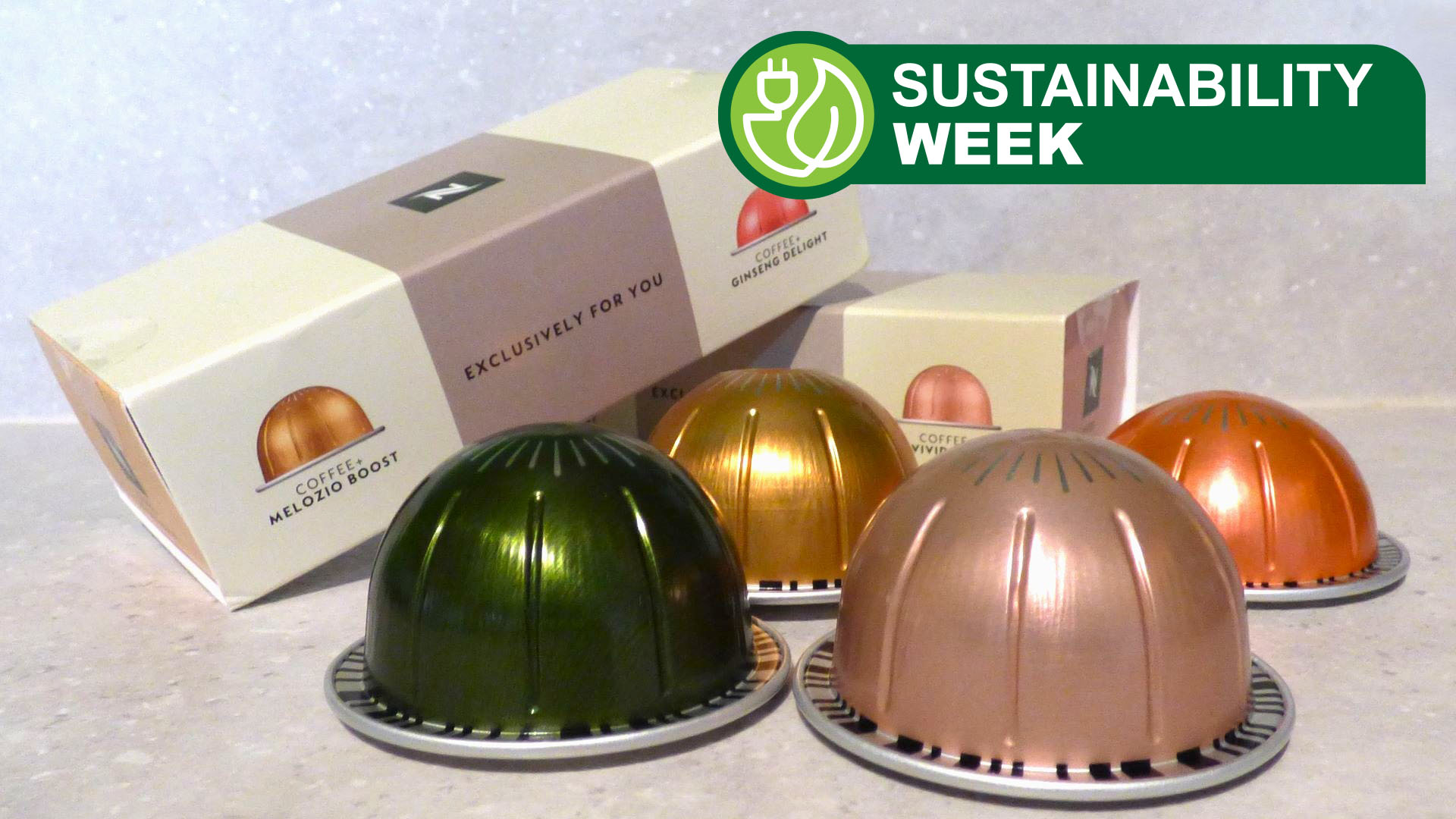
Coffee pods are one of the most popular ways to brew coffee, and a recent survey by Deloitte found that 25% of regular coffee drinkers used capsules when preparing their drinks. It’s easy to see the appeal – there’s none of the mess or hassle of using fresh beans (whether you’re making espresso or drip coffee), and the foil-sealed pods give a better flavor than freeze-dried granules.
Convenience isn’t the only benefit, though. An increasing number of speciality coffee roasters are producing their own capsules filled with their own ground and measured beans, and the big companies like Nespresso and Keurig are increasing their ranges of single-origin coffee too. For example, Wogan Coffee, where I completed my Specialty Coffee Association certification, sells its own range of Nespresso-compatible roasts in capsule form.
The disadvantage of pods is the waste. If you grind your own beans then you can dispose of the grounds in household food recycling, add them to a compost heap, or use them in your garden, but aluminum pods aren’t so easy to handle and need specialist recycling.
In the UK, Nespresso has a program that lets you send your used pods for recycling using a free bag, or drop them off at a Nespresso boutique. You can also use the Podback scheme, which handles Nespresso, Illy, and Tassimo capsules, and 18 months ago launched a partnership with Royal Mail to collect pods from your doorstep.
But what happens to your used pods once they’ve arrived for recycling? How are the coffee and the capsule separated, how are they processed, and what about the recycling bag?
To find out what happens behind the scenes, and to learn about the challenges around recycling coffee capsules, we spoke to Mary O’Rourke, Sustainability Manager at Nespresso UK and Ireland.

Mary O'Rourke began her career as a sustainability consultant before joining Nespresso in 2017. Since then, she has mainly been focused on projects surrounding the company's life cycle assessments and enhancing its recycling services, and eventually led the launch of Podback, the UK-wide takeback program for coffee pods, on behalf of Nestlé and Nespresso.
What is the biggest challenge with encouraging people to recycle their used Nespresso pods?
Many consumers want to recycle their coffee pods but often don’t know how. We’re on a mission to recycle every pod and that means making more people aware of our programs, so they understand just how simple it is.
Get daily insight, inspiration and deals in your inbox
Sign up for breaking news, reviews, opinion, top tech deals, and more.
With the Royal Mail partnership, you can recycle coffee pods from the comfort of your home. Through the booking portal, you can select 'Home collection', or you can drop off your pods for recycling at one of the 14,000+ Royal Mail locations or any Nespresso boutique. We also provide recycling services in Ireland, Guernsey and Jersey via the local postal service.
What is the process once the pods have been collected?
In the UK, pod bags are transported to a recycling facility. At a high level, here’s what happens next:
1. Turbo separation
The bags enter a turbo separation chamber where centrifugal force induces the separation of the bag, aluminum, and coffee grounds.
2. Bag recycling
The plastic bag is separated first and sent to a third party for recycling into new products.
3. Coffee grounds processing
The remaining materials pass through a series of screens. The finest screen allows the coffee grounds to pass through. These grounds are collected and transported via a third party to produce biogas (renewable energy) and digestate (soil improver).
4. Aluminum recovery and processing
The aluminum is then separated, cleaned, set aside for smelting, and poured into large blocks. A series of additional, smaller technical steps are implemented along the way to ensure maximum recovery and quality of the aluminum, so it can be transformed into something new.
Note: 80% of our pod collection bags and at least 80% of the aluminum in at-home coffee pods are made from recycled content.
Does the process differ in the UK and the US (or other countries)?
Yes, recycling processes differ between markets depending on local context and infrastructure. We share knowledge amongst markets to help one another test and adopt each other’s recycling efforts. Whenever possible, our aim is to transition to a collective system to allow consumers to recycle their used pods in their usual refuse systems. It’s something we’re working towards in the UK and have already seen the success of it in 11 countries that have full or partial access to a collective scheme.
We’re always seeking ways to innovate, partner, and simplify recycling for coffee-lovers and Belgium is a great example of what can be possible. As of January 1st, 2023, all coffee pods, regardless of brand or material used, can be sorted and recycled via Belgium’s public collective scheme, in their so-called ‘Blue Bag’. This is the result of a partnership initiated by Nespresso, other Nestlé coffee brands, Fost Plus and another major producer and retailer. It’s inspiring to see the industry work together to create long-lasting change.
Do you know what proportion of Nespresso customers currently recycle their used pods?
While I don’t have exact figures for the UK, we have seen an upward trajectory with pod recycling over the last couple of years through our partnerships, and our global rate is 35%. Our customers continue to show a genuine interest in recycling and are taking more action. As a business, we’re committed to improving this by making recycling more convenient for consumers.
Since 2014 Nespresso has invested over CHF 550 million [about $680 million / £500 million / AU$1 billion] in its recycling programs globally in 71 markets, where more than 90% of Nespresso capsules are bought by consumers who have access to a convenient recycling option. By 2030, we aim to achieve a global capsule recycling rate of 60% (collective and dedicated systems).
We are therefore further accelerating the work we started in 2014 and will make continuous investments to make recycling as simple and convenient as possible for our consumers.
Is there anything else you want to share about the Nespresso recycling program?
Our circularity work doesn’t stop with our pods. Our view is that resources are precious and should be kept in use or be recycled when possible.
Another example of our circularity ambition is the Preloved program. A Preloved machine is a Nespresso machine that has been returned to Nespresso, or it incurred minor damage through external or internal handling, and it has been given another life.
After being returned to Nespresso, the machine is carefully assessed to see if it can be refurbished or not. If the machine can be refurbished, it will be carefully inspected, repaired, cleaned, tested and repackaged, preventively maintained, by our trained technicians, thus becoming a Preloved machine. [Repairs and maintenance are subject to availability, and may be subject to color and range restrictions.]
In 2024, our Preloved machine refurbishment program was launched into seven new markets, taking us to 21 in total. The ambition is that Preloved products will be accounting for 10% of machine sales by 2030.
You might also like
- Inside Fairphone, the smartphone maker offering a better deal for the planet
- 5 environmental movies with over 93% on Rotten Tomatoes streaming on Netflix, Prime Video and more this Earth Day
- Applying 'extreme heat' to lithium-ion batteries reportedly restores their capacity, and I think it could be the sustainable tech breakthrough of 2025

Cat is TechRadar's Homes Editor specializing in kitchen appliances and smart home technology. She's been a tech journalist for 15 years, having worked on print magazines including PC Plus and PC Format, and is a Speciality Coffee Association (SCA) certified barista. Whether you want to invest in some smart lights or pick up a new espresso machine, she's the right person to help.
You must confirm your public display name before commenting
Please logout and then login again, you will then be prompted to enter your display name.